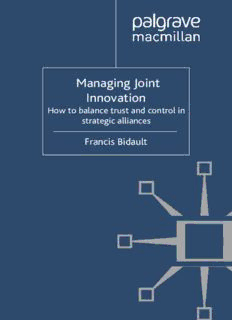
Managing Joint Innovation: How to balance trust and control in strategic alliances PDF
Preview Managing Joint Innovation: How to balance trust and control in strategic alliances
Managing Joint Innovation How to balance trust and control in strategic alliances Francis Bidault Managing Joint Innovation This page intentionally left blank Managing Joint Innovation How to balance trust and control in strategic alliances Francis Bidault Professor, ESMTEuropeanSchoolofManagementandTechnology Palgrave macmillan ©FrancisBidault2012 Softcoverreprintofthehardcover1stedition2012978-0-230-27997-1 Allrightsreserved.Noreproduction,copyortransmissionofthis publicationmaybemadewithoutwrittenpermission. Noportionofthispublicationmaybereproduced,copiedortransmitted savewithwrittenpermissionorinaccordancewiththeprovisionsofthe Copyright,DesignsandPatentsAct1988,orunderthetermsofanylicence permittinglimitedcopyingissuedbytheCopyrightLicensingAgency, SaffronHouse,6–10KirbyStreet,LondonEC1N8TS. Anypersonwhodoesanyunauthorizedactinrelationtothispublication maybeliabletocriminalprosecutionandcivilclaimsfordamages. Theauthorhasassertedhisrighttobeidentifiedastheauthorofthiswork inaccordancewiththeCopyright,DesignsandPatentsAct1988. Firstpublished2012by PALGRAVEMACMILLAN PalgraveMacmillanintheUKisanimprintofMacmillanPublishersLimited, registeredinEngland,companynumber785998,ofHoundmills,Basingstoke, HampshireRG216XS. PalgraveMacmillanintheUSisadivisionofStMartin’sPressLLC, 175FifthAvenue,NewYork,NY10010. PalgraveMacmillanistheglobalacademicimprintoftheabovecompanies andhascompaniesandrepresentativesthroughouttheworld. Palgrave®andMacmillan®areregisteredtrademarksintheUnitedStates, theUnitedKingdom,Europeandothercountries. ISBN978-1-349-32717-1 ISBN978-1-137-28411-2(eBook) DOI 10.1057/9781137284112 Thisbookisprintedonpapersuitableforrecyclingandmadefromfully managedandsustainedforestsources.Logging,pulpingandmanufacturing processesareexpectedtoconformtotheenvironmentalregulationsofthe countryoforigin. AcataloguerecordforthisbookisavailablefromtheBritishLibrary. AcatalogrecordforthisbookisavailablefromtheLibraryofCongress. 10 9 8 7 6 5 4 3 2 1 21 20 19 18 17 16 15 14 13 12 C ONTENTS ListofFigures andTables vi Preface ix Chapter1 Theworldofalliances 1 Chapter2 Theeraofalliances 17 Chapter3 Cooperationcasualty 44 Chapter4 Relationalquality 62 Chapter5 Thelifeofanalliance 98 Chapter6 Strategyformulation andpartner selection 129 Chapter7 Alliancenegotiation andformation 159 Chapter8 Allianceoperationandturnaround 186 Chapter9 Alliancerecoveryandtermination 209 Chapter10 Monitoringrelationalquality 230 Conclusion 253 Appendix–INTOPIA: Alearningtoolfor alliancemanagement 257 Notes 270 Index 285 v F T IGURES AND ABLES Figures 1.1 Carelman’sdouble-handed axe 2 1.2 Cooperation asanalternative between “make”and“buy” 6 1.3 Alliancesasanalternativebetweenmarkets andhierarchy 7 1.4 Thevarietyofallianceforms 8 2.1 Thevaluenetwork 23 2.2 Organizational capabilities 26 2.3 Capabilitydevelopmentandcontribution inalliances 29 2.4 Industry-financed R&Dexpenditures (measuredasapercentageoftheGDP) 34 2.5 Numberofpatentsgrantedinthetriad regions,1995–2005 36 2.6 Thesemiconductorindustry,1980–2010 37 2.7 Keyplayersintheopeninnovation model 39 3.1 A dynamic view ofkeyalliancesuccess factors 58 4.1 Differentformsoforganization within alliances 93 5.1 Theratesofterminationofjointventures 104 5.2 Thecycleofrelationalquality 117 5.3 Theevolutionofrelationalquality 121 5.4 Reasonsforrelationalqualitytodrift 124 6.1 Aframeworkforselectingbetweenmake, buy,andally 137 6.2 Howalliancepartners fittogether 141 6.3 Horizontal,vertical,andunrelatedalliance partners 143 vi ListofFiguresandTables vii 6.4 Partners’ assetsandskillscontributions 145 6.5 Thenumberofpartnersandthebalanceof power 148 6.6 Theformsofalliancegovernance 150 6.7 Thepyramidofalliances 153 6.8 Trust,control,andalliancegovernance options 156 6.9 Governance optionsgiventhetypeof uncertainty 157 7.1 Alliancesaswin-winarrangements 165 7.2 Thewin-winrange:thecaseoftechnology licensing 166 7.3 Adynamicviewofrelationship building 172 7.4 TheFAcT-Mirrormethod 179 7.5 ThestepsoftheFAcT-Mirrormethod 180 7.6 Buildingrelationalqualityintheformation phase 183 8.1 Acycleofrelationalqualitydeterioration 196 8.2 Rescuingrelationalqualityintheoperation phase 206 9.1 Bottompairtrawling 217 9.2 Relationalqualityrecoveryoralliance termination 221 9.3 Easyorhardexitfromalliances 225 9.4 Terminationtrajectories 227 10.1 Regularmonitoringofrelationalquality 233 10.2 Mutual trustandcreativity 235 10.3 Trustinthepartnerandinvestment 237 10.4 Controlandperformanceofalliances 239 10.5 Arelationalqualitydashboard 241 10.6 Amodelformonitoringrelationalquality 243 10.7 Thevariousstakeholdersinvolvedinthe monitoring ofrelationalquality 245 10.8 Relationalqualitysurveytimeline 247 A.1 ThebusinesscontextofINTOPIA 263 A.2 Horizontal partnerships inINTOPIA 265 A.3 Verticalpartnerships inINTOPIA 265 viii ListofFiguresandTables Tables 2.1 AsampleofCorning’sjointventures 19 4.1 Teamsvscommitteesinco-development alliances 71 4.2 Themixoftrustandcontrol 92 5.1 Thenormal evolutionoftrustandcontrol overtime 115 6.1 Optionsfordevelopingcorecapabilities 136 6.2 Conditionsforthestrategic andculturalfit 138 8.1 Mechanismsofrelationship repair 205 P REFACE The content of this book is primarily addressed to execu- tivesandmanagerswhoare,oratsomepointintheircareers will be, in charge of heading co-development alliances and who are looking for a comprehensive framework on which to base their actions, especially regarding interaction with the partner firm and its staff. There is substantial evidence, as will be shown in the first three chapters, that the quality oftherelationshipbetweenpartnersisastrongdrivingforce behind the success of alliances. In Chapter 2, we will define thisconceptwithsufficientrigorandenoughpracticalityto makeitavariable thatcanbemanaged. The concepts and frameworks presented in this book are based on solid academic references and are illustrated with numerous case studies to highlight issues from an execu- tive’s perspective. This book, however, is more than just an attempt to summarize prior research. It contains orig- inal propositions and attempts to offer a self-contained framework that can serve to improve the management of co-developmentalliances. As can be expected, the idea of this book did not come suddenly. It feels like I carried it over the many years since I developed an interest in the study of strategic alliances. Havingbeeninvolvedextensivelyinthewritingofcasestud- ies for many years, I can easily trace the beginning of my own personal journey in this fascinating world. It really started in 1989 with field research on an alliance between Digital Equipment Corporation and ITT with my old pal TomCummings. Since then, I have been involved in numerous projects, be it research, courses, or management seminars. But three projects have recently re-ignited my interest in alliances. ix
